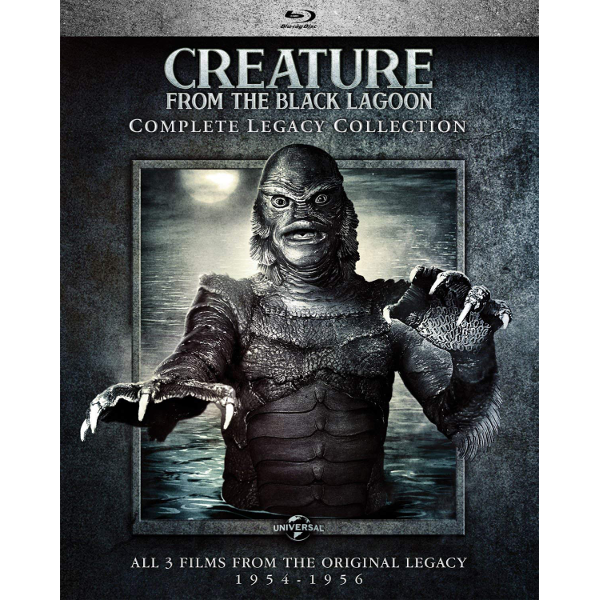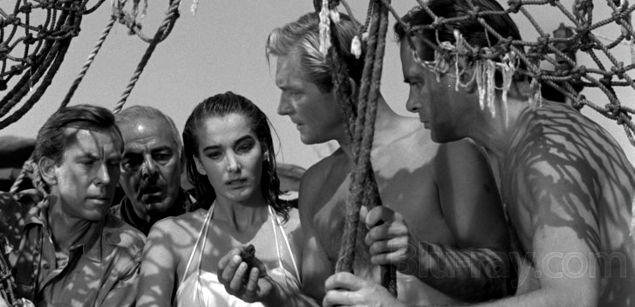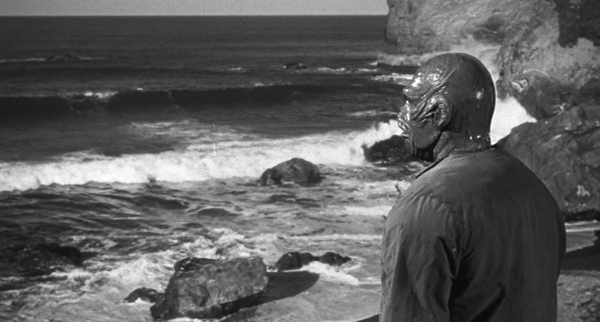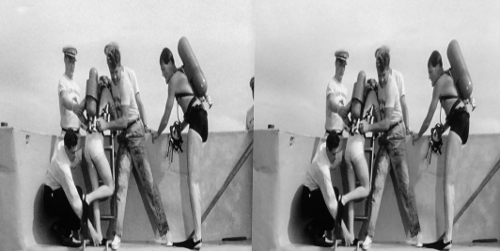Creature From the Black Lagoon Complete Legacy Collection
It’s controversy in the Black Lagoon! Universal releases a much-desired box of all three Gill Man epics — but goes cheap on the encoding and hands us a 3-D rendering of Revenge of the Creature at half-resolution. When is a Blu-ray not a Blu-ray? When it’s not even full HD. And all that after commissioning a state-of-the-art 4K 3-D video remaster.

Creature From the Black Lagoon: Complete Legacy Collection
Creature from the Black Lagoon (3-D + 2-D), Revenge of the Creature (3-D) + 2-D, The Creature Walks Among Us (2-D)
Blu-ray
Universal Studios Home Entertainment
1954-1956 / B&W / 1:85 widescreen / 79, 82, 78 min. / Street Date August 28, 2018 / 39.98
Starring: Julie Adams, Lori Nelson, Leigh Snowden, Nestor Paiva, Richard Carlson, Jeff Morrow, John Agar, Rex Reason, Richard Denning, John Bromfield, Jeff Morrow, Greg Palmer…
and as the Gill Man: Ricou Browning, Ben Chapman, Don Megowan, others.
Cinematography: William E. Snyder; Charles S. Welbourne; Maury Gertsman
Film Editors: Ted J. Kent; Paul Weatherwax; Edward Curtiss
3-D restoration for Blu-ray by The 3D Film Archive
Original Music: Robert Emmett Dolan, Henry Mancini, Milton Rosen, Hans J. Salter,
Herman Stein; William Lava; Heinz Roemheld
Written by Arthur A. Ross, Maurice Zimm, Harry Essex; William Alland,
Martin Berkeley
Produced by William Alland
Directed by Jack Arnold, John Sherwood
Universal has topped off their Blu-ray upgrades with a Creature From the Black Lagoon: Complete Legacy Collection that reproduces the contents of a 2004 DVD set, but with highly-desired 3-D presentations: the 3-D encoding given the first Creature movie was first seen in 2012, and a newly-restored and remastered 3-D presentation of the first sequel. The 2nd sequel was only produced flat. Had Blu-ray 3-D continued to be supported by studios for the U.S. (they regularly release 3-D content overseas), by this time it might have been practical to do a quick fake-3-D conversion of the third picture as well.
That pipe dream for monster fans fades as we find out that Universal has short-changed its loyal customer base, with a format cheat on the presentation of the first sequel. More on this below.
The best and practically the only original 1950s movie monster is everyone’s favorite denizen of the Amazon, The Creature, aka the Gill Man. Drummed up by Universal when studios were still putting resources and effort into far-out fantastic films. The Creature aka the Gill Man is a beautifully designed and executed fish-monster, perhaps the best rubber-suited thing Hollywood ever turned out. His three starring vehicles barely tap his engagingly feral personality but he has always had a big appeal for kids who like their monsters big, slimy and savage. When Aurora’s plastic model kit appeared in the early 1960s, The Creature was the most exciting — even though I hadn’t seen any of his movies.
Universal’s Legacy Collection gathers the original feature and its two sequels together on Blu-ray. I once remember buying them on laserdisc for about $85, and that was without any extras save for perhaps a trailer. This two-disc set ought to be the favorite studio library release of the year. . . but somebody at Universal figured out a way to save some money and compromised the quality of the new 3-D restoration.
They may be neither classy nor classics but the Creature trilogy remains well above the standards of most ‘fifties monster movies, including most of Universal’s efforts. The origin of ‘the Gill Man’ is no longer obscure; Tom Weaver’s book The Creature Chronicles gathers a wealth of ‘biographical’ information. Derived neither from a book nor recorded legend, The Creature is an original Hollywood fish story. Although classified as science fiction he has little to do with the ’50s sci-fi craze. As Tom Weaver prompted producer Alland to admit, his story was a retread of King Kong, which had enjoyed an enormously popular theatrical revival in 1952. When combined the first two movies form a similar plot line centered on the monster’s efforts to possess the leading lady.
The Creature trilogy isn’t exactly Shakespeare, but it has always pleased fans of a very special movie monster.
Creature from the Black Lagoon (1954):
Starry-eyed scientist David Reed (Richard Carlson), adventurer-investor Mark Williams (Richard Denning) and curvaceous Kay (Julia Adams) penetrate the Black Lagoon to search for a full fossil to match the skeletal claw discovered by professor Carl Maia (Antonio Moreno). But the aquatic man-fish that greets them takes an instant liking to the way Kay fills out her contoured swimsuit. The Gill Man decimates the supporting cast while the leads debate various methods of capture. The wily Devonian blocks their exit from the Lagoon and claims Kay as a romantic spoil of war. But you know what they say about fish and visitors after three days.
The first movie was made by eager talent itching to pull off a scare-show in 3-D. Jack Arnold was an unpretentious director less interesting than the fantastic subjects he ended up helming for the studio system; he’d later transcend the sci-fi ghetto with his wonderful film of Richard Matheson’s The Incredible Shrinking Man. With the exception of a few atmospheric moments the Creature is a rather literal mutant fish that remains a threat because the explorers are caught in his claustrophobic jungle lagoon. The monster has the element of surprise when encountered underwater or in dark and confined spaces. Audiences of 1954 responded to the erotic charge in the Creature’s stalking / underwater ballet with Julia Adams’ Kay; John Baxter first called it out as film art in his book Science Fiction in the Cinema, and the cult for director Jack Arnold was born.
The first two films must prop up fairly artificial storylines to stay afloat. People wander idly when they know a menace could be sneaking up on them; blasts of trumpet music accompany the monster’s every un-sensational appearance. The Creature does a lot of reaching blindly onto footpaths and through portholes with a trembling claw that’s supposed to be terrifying. Instead, we admire the artful sculpting of his webby scales. Different suits were used in the water and on land. The actors playing the monster give his actions real dynamism, even in rough stunt scenes.
The first two movies were produced in 3-D and look great in a process that thrived on artificial thrills — hands poking into the camera, the Creature leaping up a ten-foot aquarium wall into a giant groggy close-up. In the original Polaroid projection system audiences saw underwater scenes in 3-D for the first time, a novel extra gimmick. I was too young to be there in person but I’ll bet that the Creature was welcomed by kids that had never experienced the excitement of Universal’s classic 1930s monsters. Basically a nice guy, the monster makes mincemeat of the cast only because they won’t leave him alone or because he’s attracted to a girl from the wrong side of the evolutionary tree. The Gill Man is funny but cool — he’s at least as convincing as the human cast, and monster fans find him irresistible.
I always thought the true sequel to Creature from the Black Lagoon should be a courtroom drama, The Black Lagoon Murders. Let’s see, eight of you go into the jungle and four come back. We’ve got a stack of mutilated corpses and a fishy story about a deadly missing link monster? No photos, no evidence, no nothing? I see some long prison terms in the future.
Revenge of the Creature (1955):
The first sequel became one of the very last releases of the first big 3-D craze, but unlike some unlucky titles that were only released flat we’re told that Revenge racked up a substantial number of 3-D bookings. A new group of scientists has little difficulty snaring the Gill Man and carting him off to a seaquarium in Florida, there to become a sideshow chained to the bottom of an exotic fish tank. Scientist Clete Ferguson and graduate researcher Helen Dobson (John Agar & Lori Nelson) carry on a spirited romance within sight of the jealous Gill Man, prompting the monster’s timely escape and subsequent reign of aquatic terror. The amphibious Don Juan mauls Helen’s dog into puppy chow. He tries to tow her to South America but is undone by the necessity of leaving her on the beach while he takes periodic breathing breaks in the surf. Clete catches up and tricks his romantic rival into letting Helen go. He uses lessons taught during negative-reinforcement sessions: namely, yelling ‘stop’ into a megaphone.
The Revenge of the Creature is an okay follow-up that completes the King Kong formula of an exotic creature brought back to civilization. Although he never reaches a big city the monster does look great while struggling in a variety of man-made locations. Revenge actually diminishes his stature a bit. He’s reduced to a goldfish in a bowl getting yelled at and poked with an electric prod, that incidentally would shock everything else in the water too. The suspense holds up, even with a break to watch the ‘Ocean Harbor’ act of ‘Flippy the Educated Porpoise.’ A fun nighttime sequence sees the creature turning Peeping Tom to spy on Lori Nelson in her bathroom, something that even giant Tarantulas tended to do over in Universal City. We get about eight minutes of classy rampage action and considerable travelog filler. Too much of the dialogue is redundant ‘radio talk’ telling us what we’re seeing: while unloading the fish-man in Florida, someone is always giving instructions for procedures already underway.
The first film remains a classic because it features the poised and graceful Julia Adams, the Gill Man’s favored swim partner. The second show also tries for a theatrical flow but Jack Arnold seems tasked to just block out the action clearly. It’s true that John Agar doesn’t have much of a flair for acting but Arnold directs as if the dialogue in Revenge isn’t worth listening to. Lori Nelson’s offhand explanation of icthyology shows that she can barely pronounce the word. At age 21 she’s naturally gorgeous but Arnold sees to it that she’s over-dressed and heavily made-up, just like Mara Corday in Tarantula. The show is now famous for an early (the first?) film appearance of Clint Eastwood, whose little gag with a white mouse can’t have been a show-stopper. The future superstar must unfortunately share his one scene with a chimpanzee.
The scene in which the Creature swims ‘with’ Lori (or her double) and tickles her heel, covers the same ground as the original. The trailer-worthy thrill moments are brief but memorable — a car overturned, a baby menaced. In a depth setup raking down a long pier, the Gill Man makes his best entrance snatching a late night date from the dance floor of a restaurant bar. His final nightime rampage in a harbor and on a beach has some of the series’ most effective lighting, especially in 3-D.
The Creature Walks Among Us (1956):
The second sequel pursues a surprisingly original story idea. A third gaggle of scientists bags the Creature in his Florida bayou hideout, accidentally giving him serious burns in the process. One harebrained theory later, the Gill Man’s fish scales have been removed, revealing a fleshy proto-man underneath. The moneybags behind the research William Barton (Jeff Morrow) professes far-fetched ideas about surgically converting animal life — and even humans — to short-cut evolution and ‘adapt’ them to new environments. Dr. Thomas Morgan (Rex Reason) opens up the monster’s unused lungs, making him a land-based creature from then on. Barton’s yacht floats the captured Gill Man (Lung Man?) all the way to his ranch overlooking Sausalito, just North of San Francisco.
It is theorized that the now more subdued monster may respond to kindness and forget his feral heritage. Morgan preaches pacifism but Barton takes the same hubristic, domineering attitude with the Creature that he does to everyone else in his life — they’re his property to do with as he wishes. His young wife, hot number Marcia Barton (Leigh Snowden) has already attracted the attention of boat skipper Jed Grant (Gregg Palmer). Knowing she can’t make Barton happy, she soon reveals a preference for handsome Dr. Morgan. As if disturbed by all this human jealousy and duplicity, the Creature rebels against being penned in with sheep and goes on a well-deserved rampage.
By the time of The Creature Walks Among Us Universal was already doing more TV work and was cutting corners. The monsters were soon demoted to a lower tier of production. Ambitious fantasies like The Mole People ended up looking like PRC groaners of ten years previous. Writer Arthur Ross (reportedly the true auteur of the trilogy) tailored a cost-cutting second sequel with a clever ruse: instead of another difficult shoot with a labor-intensive rubber full-body suit, Walks mostly uses outtakes from the first two films to show the Creature in his original amphibious form. Post- transformation, he’s a more easily managed monster with just a head mask, new hands and new feet. A gunny-sack zoot suit covers the rest of him.
Voila! Except for a few new shots to depict his capture, the earlier full crew of latex wranglers are replaced by one or two guys touching up a couple of hunks of rubber. Any big actor can don the gear and nobody has to stay in an unbearable rubber suit for eight hours at a clip. Six foot six-inch Don Megowan made the Creature seem appropriately gigantic. He had both the mime skill and the necessary stamina to work for long hours in costume.
One might think that the surgical makeover done on the poor Gill Man might have introduced a creepy Doctor Moreau feeling. The scientists basically skin him alive and call it an act of kindness. Doctor Barton seems to think that converting the Gill Man for dry land will give us knowledge on how to convert humans to live in space, or on other planets.
The science talk in the first two films was mostly time filler but the screenplay for Walks Among Us has a modicum of complexity. The Creature’s natural savagery is favorably compared to his human captors’ aptitude for violence and wrongdoing, a formula that gives the characters motivation and the storyline a purpose. The mighty Gill Man is now a pitiful lummox caged in a sheep pen. His new experiences with human feelings are not fully articulated by the script, although John Sherwood’s direction nicely conveys the monster’s alienation. The Creature kills a mountain lion, having graduated to become a guardian of wooly rights. Some fish, as they say.
Screenwriter Ross keys the monster into a soap opera plot that Douglas Sirk could appreciate, especially with Dr. Barton’s fancy car, yacht and trophy wife: ‘Written on the Mackerel?’ Dr. Barton creates a hostile atmosphere, encouraging Jed Grant to lure Marcia into compromising situations. Marcia is the best screen role for actress Leigh Snowden, whose previous filmic highlight was as a poolside girl in Kiss Me Deadly. Halo-pure Rex Reason observes virtuously from the sidelines but apparently steps in to claim Snowden’s dance card at the finale. Almost predicting the violent rebellion of The Birds, the Creature observes Barton’s jealous arguments and finally witnesses a murder. There’s no going back to the Black Lagoon now: the once- mindless beast is now a moral judge endowed with human wisdom. When he can’t stand any more he rips free of his cage to smite the offenders.
But The Creature Walks Among Us works because the title beast is fully integrated into the drama — and has a thoughtful quality lacking in formulaic monster efforts. Doubtless this was all made possible simply because the studio didn’t care about the picture. You can bet that few top execs paid much attention to it at screenings.
By 1956 the studio apprentice system was shutting down. John Sherwood had been a crack assistant director since the 1930s but bigger assignments didn’t follow as they had for Jack Arnold, who had broken into direction years earlier. Sherwood’s direction of this film and the micro-budgeted The Monolith Monsters show more care and promise than much of Jack Arnold’s fantasy output. Sherwood can claim the best-directed scene in the whole trilogy, when the Creature invades the mansion house to punish the abusive Jeff Morrow. Excellent blocking shows the monster parallel- pursuing first Rex Reason and then Morrow through a series of rooms. He spots his prey out of the corner of his eye at the same time we do, and then barrels through a window to cut off the escape route. The action is beautifully laid out for maximum involvement — the fast-moving Creature seems intelligent as well.
John Sherwood contracted pneumonia and passed away just three years later, at age 56; he had returned to assistant directing. Depending on who was interviewing them, both William Alland and Jack Arnold either dismissed their Universal fantasy work or hogged credit for the films. Arnold even tried to take credit for directing parts of the expensive This Island Earth. Alland claimed not to remember Walks Among Us while Arnold said he was eager to pass it on to ‘somebody else.’
The sensitive direction falls short only at the rushed ending, with an intriguing dramatic situation that isn’t fully exploited. The escaped monster stands atop a sand dune, staring at the ocean waves. We’re aware that he can no longer breathe underwater so perhaps he’s a goner for sure. But does the Creature know that? Is he committing suicide or just going home? Thanks to the ‘progressive’ scientists the formerly feral mer-man is now a humanoid freak, fully functional neither on land nor in the water. If the movie had fully acknowledged this subtext by lending the last scene a tiny bit of visual finesse, Universal’s Creature could have been given a truly enigmatic and thought-provoking farewell.
The Universal Studios Home Entertainment Blu-ray of Creature From the Black Lagoon: Complete Legacy Collection was for classic monster fans the most highly-awaited release of the summer. It caps off the studio’s other legacy sets, which sell at the same price point but contain as many as four discs. Putting two features on one Blu-ray disc doesn’t strain the format’s capacity, especially with B&W and the mostly short running times involved. For Creature from the Black Lagoon Universal only had to press some more of its 2012 Classic Monsters discs, which contain beautiful Blu-ray encodings both flat and 3-D. The Black Lagoon disc received excellent notices from the 3-D Film Archive, with the caveat that the settings for the underwater shots weren’t optimized — we don’t get quite the full ‘surrounded by bubbles’ depth effect.
This Blu-ray Creature Legacy Collection presents all three of the films in their proper widescreen (1:85) aspect ratios, eliminating ‘dead’ visual real estate and focusing the dramatic action. In his vintage commentary for Black Lagoon, Tom Weaver referred to a visible telephone pole at the headwaters of the Amazon as a blooper. Properly matted to 1:85, Ma Bell’s poles are nowhere to be seen.
Happy 3-D- enabled consumers were delighted that Universal was continuing the format for this great revival title. But as soon as new product reached the hands of fans and reviewers, the Legacy Collection blew up like a bomb. Presumably to save money, both Revenge of the Creature and The Creature Walks Among Us have been encoded onto the same disc, using a greatly diminished bit rate to fit everything in — that’s two versions of Revenge and one of Walks, all crammed into one disc. The website The Digital Bits has stated that the 3-D of Revenge isn’t even full HD — not 1080p, but only 720p.
The encoding also doesn’t behave like most 3-D discs. On my LG set, instead of automatically switching to full 3-D, it simply displays the twin side-by-side stereoscopic images. One must manually hit the 3-D button on the monitor’s remote and choose the right configuration. That’s not difficult, but I’ve never had to do it before. I have no idea what consumers with older sets, or with ‘active’ battery-powered glasses must do. Four of my readers assumed that the problem was faulty programming, and wrote me that they’d already returned the disc to Amazon.
The finished product must be frustrating for the experts that engineered, finessed and optimized the 3-D restoration for Universal — not only has their work been compromised, they haven’t even received credit. As explained in their article, digital manipulation enabled the fixing of all manner of alignment flaws, eliminating 3-D problems inherent in the original photography. Using Universal’s excellent 4K left eye/right eye scans, the specialists even corrected shots where the left and right eye negatives had been swapped, ruining the 3-D effect.
Missing but not badly missed is the original 3-D Intermission with its special cards. We can still see the double fade right where the intermission was placed, however.
The disc is a real puzzle of corporate decision making. Universal commissioned a top-flight 3-D restoration for Revenge, only to severely compromise the release by jamming too much onto one disc. The 2-D version of Revenge suffers as well. With its diminished bit rate, it looks no better than a DVD.
Just how does the compromised Revenge of the Creature look? Universal surely considers it acceptable even though it is way below the industry standard. Blu-ray 3-D normally looks every bit as good as flat encodings. Revenge is definitely inferior to the 3-D Black Lagoon on the first disc. Thinking positively, the underwater 3-D effect is is an improvement — those fish in the foreground really seem to be floating in the middle of my living room. But Revenge feels pale: less bright, less sharp and lacking the contrast ‘punch’ that one gets from full resolution Blu-ray 3-D. I’ve shown off my 3-D setup for many guests, most of whom had only vague memories of anaglyphic 3-D that never looked good. The Blu-ray 3-D on Mad Max, Kiss Me Kate and the first Creature blew them away, turning doubters into Blu-ray 3-D fans.
Some ‘legacy,’ Universal! Saving a few dollars with a less than optimal encoding smacks of contempt older home video companies had for consumers, when they put out worthless ‘extra long play’ VHS tapes. They also tossed old pan-scan tape transfers onto DVD, something that even happened with films by Stanley Kubrick. We 3-D fans are happy that the studios haven’t completely abandoned the format, even if we have to go to Europe to obtain 3-D releases of things like Pixar’s Coco.
I’m predicting that Blu-ray 3-D might bounce back (perhaps with UltraHD 3-D?) when James Cameron’s Avatar sequels arrive. If Universal has any respect for its customers it will find a way to correct its Creature Legacy Collection as a professionally formatted Revenge of the Creature 3-D.
The set retrieves the familiar extras from the old DVD restorations, some of which were produced by the respected David J. Skal. Tom Weaver’s welcome commentaries cover all three pictures, with added lively banter from Bob Burns and Lori Nelson on the sequels. David J. Skal’s original Creature docu presents an abundance of Gill Man- related Hollywood lore such as the various he-men who portrayed the Creature and a primer on his various sculpted versions — the underwater monster suits were appreciably different than the walking-around monster suits. Mention is also made of the Gill Man’s nominal appearance in Billy Wilder’s The Seven Year Itch. Since the Creature inspired Marilyn Monroe’s emotional outburst on her way to that famous subway grating I always thought it appropriate that the famous photo of her skirt flying over her head should be amended, adding a scaly webbed claw reaching up from below.
The extras include lots of production stills. One notable Revenge action still has Lori Nelson being manhandled by the Creature in the water during her kidnap. The backlight shows her hair flying and flinging water as she screams. It’s actually a frame blow-up from the movie. The pose always looked familiar, but I didn’t know why until one day I realized that the screaming female victim on the key poster art for 1963’s The Day of the Triffids is a copy of the exact same image, right down to the white summer dress worn by both female victims. Somebody tell Lori Nelson!
I still stand by my philosophical / biological doubts, the question that cuts to the very core of Creature-philia: in the first film, does the Creature room with the Phantom of the Opera? What are those columns in his subaquatic lair, the ones that look like organ pipes? Also: The Gill Man comes from the headwaters of a tributary of the Amazon. That should make him a fresh-water, finger-snapping kind of guy. Why doesn’t he turn belly-up and float dead when they dump him into a salt-water oceanarium tank? Hm? Yeah? Real scientists wouldn’t make a goof like that.
Reviewed by Glenn Erickson

Creature From the Black Lagoon: Complete Legacy Collection
Blu-ray rates:
Movies: all Very Good
Video: Lagoon Excellent; Revenge Fair (non-HD resolution); Walks Very Good
3-D: Lagoon Excellent, Revenge Fair
Sound: Very good
Supplements: Back to the Black Lagoon documentary, production stills, commentaries with Tom Weaver, Bob Burns and Lori Nelson; trailers.
Deaf and Hearing Impaired Friendly? NO: Revenge 3-D has no subs.
Packaging: Keep case
Reviewed: August 29, 2018
(5810crea)
Visit CineSavant’s Main Column Page
Glenn Erickson answers most reader mail: cinesavant@gmail.com
Text © Copyright 2018 Glenn Erickson











